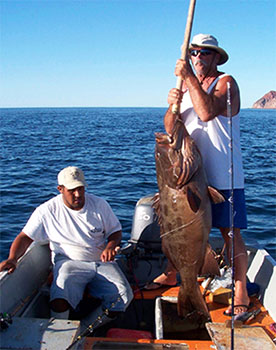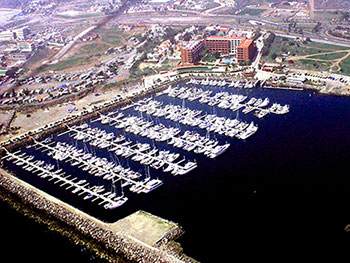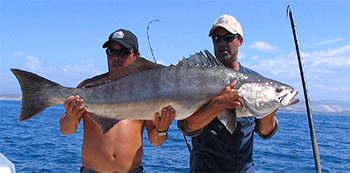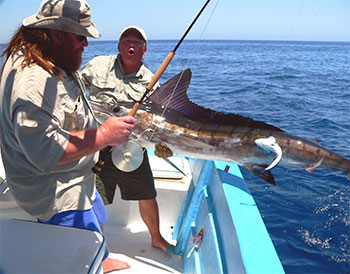 |  |
By Tom Gatch

While residents of Midwestern and northeastern states may already be bracing themselves for the chilly fall and winter season to come, those lucky enough to live in southern California and Baja still have several months of sunny, summer-like weather on tap. This is also a time of year that marks a peak period of activity for a wide variety of Baja’s most popular gamefish species. Those seeking an easily accessible summertime angling adventure within a few hundred miles of the international border should not overlook the state of Baja California Norte. As the final southern hurricanes near the tip of the peninsula push water up along Baja’s northern Pacific coast, the offshore surface bite gets into full swing and schools of exotic pelagic species such as yellowfin tuna and dorado can often be found around northbound kelp paddies that drift just offshore.
The axiom, ‘hot weather equals hot fishing’, is probably no truer anywhere else in the world than it is in Baja California Sur. With air temperatures often in the mid-90’s and coastal waters regularly topping 85 degrees during summer, an explosive combination of dynamics are created when schools of bait, hungry gamefish and resolute anglers collide in an exciting melee that generally continues through fall.
On the other hand, the eastern coast on the Sea of Cortez, with daytime temperatures occasionally reaching the triple digits, offers some of the best summer fishing in the region. Everything from white sea bass and yellowtail, to cabrilla, grouper and a plethora of other species can be found between Islas Encantadas and the islands off of Bahia de Los Angeles. Although former Mexican President, Vicente Fox’s dream of an Escalera Nautica creating a link of marinas along the entire Baja coast within a day’s travel of one another may have not ever reached fruition, the number of quality facilities around the peninsula that accommodate boaters continues to increase.
For those cruising south from southern California, the newest and closest marina is situated between Rosarito Beach and Ensenada, just north of the Bajamar golf course. The La Salina Marina offers an excellent place to regroup before heading out in the morning to fish the rich, virtually untapped inshore fishing nearby.

Just before reaching the Port of Ensenada, the Coral Hotel with its well conceived marina will remind many stateside cruisers of similar facilities in southern California. When boating along the coast south of Ensenada in larger sailboats and cruisers, however, don’t expect to encounter such luxury until you reach Cabo San Lucas. But for most car top and trailer boats 18-feet or less in length, there remain a number of options. One of them is the launch ramp at the Estero Beach Resort, which can be used for a nominal charge by those who are not hotel guests. There are also numerous charter boats and sportfishers, both here and near the city’s main malecon, that are available to take passengers on ½ day, ¾ day and full day fishing trips in the outer bay, around nearby Islas Todos Santos and to points beyond. Summer is the best time in this region to catch one of the tastiest members of the tuna family, the long-finned albacore, as well as other popular gamesters like yellowtail, calico bass, bonito and barracuda.
Great summertime fishing is also on tap for anglers who charter a boat and guide from any of the three more southerly panga operations at Punta Banda, Puerto Santo Tomas or Erendira’s Castro’s Camp. These types of trips usually visit areas that are more remote, and generally yield more prolific and varied catches than many of the larger, commercial sportfishers in the area. Many miles further down the road; Bahia San Quintin is Baja Norte’s southernmost area offering a conventional launch ramp along with commercial sportfishing services. During the summer months, migrating yellowfin tuna and dorado join large yellowtail and a host of other offshore species to delight the many anglers that visit from southern California.

San Quintin has a decent cement launch ramp capable of handling pangas, skiffs and small cruisers, but the narrow, winding channels inside the entrada can be challenging to those mariners who are unfamiliar with the area.
South of San Quintin, the only way to launch from shore is by way of various sandy beaches; a practice that is best undertaken only by those who are extremely experienced in the art, and even then with great caution. In more remote locations, there may very well be no viable medical or rescue facilities within 100 miles of where you happen to be fishing. Stalwart Bajaphiles with 4-wheel drive vehicles still make the yearly trek down sandy, gravel roads to destinations like Punta Abreojos, Laguna Coyote and Magdalena Bay, where they can catch plenty of quality grade corvina, halibut and white sea bass right off the beach. Smaller private aircraft can also reach a number of these hidden places, since many of the fish camps also have small, dirt runways.
By the time you reach the Punta Abreojos region, Campo Rene has a hard-packed dirt ramp in a protected venue that also offers rental palapas and cottages, kayaks and hot, running water showers. The fishing in this region has become legendary over the past few decades. Further south, near Bahia Magdalena, there is a launch ramp in the town of San Carlos. But boaters, particularly those with larger craft, should be advised that it is quite narrow by most standards, and at times can be in very poor condition.
Of course, once you arrive in Los Cabos at the tip of the peninsula, a huge marina with a sophisticated network of launching and repair facilities once again becomes available. This area is also often referred to as the "Marlin Capital of the World", since more marlin are reportedly caught here than any other place on the globe.

This is indeed the place to resupply yourself with anything that you might need before moving on because, no sooner than you begin to head north along the Sea of Cortez past San Jose del Cabo, the coastline once again becomes sparse and arid with only beach launching available on the East Cape until you reach the beautiful city of La Paz, the jewel of Baja Sur’s eastern coast. This capital city is replete with colorful local history involving missionaries, pirates and a once thriving pearl industry, in addition to having a reputation for offering some of the finest sportfishing on the entire peninsula. Here, there are several private and public boat launch facilities to choose from. This is a perfect place to enjoy world-class fishing for wahoo, tuna, dorado, marlin, pargo, cabrilla and more. Visitors can also snorkel with playful sea lions or scuba dive with hammerhead sharks and giant manta rays. There are several qualified outfitters who work out of the area, and provide access to the several islands that are situated just offshore. To the north, there are also several usable launch ramps in the towns of Loreto, Mulege, Punta Chivato and Santa Rosalia. These are also extremely productive areas to fish during summer, although they can be a bit more difficult to access. This is an ideal realm for trailer boat enthusiasts who enjoy striking out on their own, and fishing off remote coasts and around small islands for a variety of species ranging from dorado and yellowtail to cabrilla and grouper. Many of these same areas also have small, commercial pangas operations that provide service to boatless anglers.
By the time you reach the Midriff Islands and Bahia de Los Angeles, more primitive conditions once again prevail, but they seem to be improving each year. There may only be a smattering of launching facilities at the present time, but those who love fishing this area look forward to a time in the near future when development reaches a point where this very special region becomes a regular destination for anglers and ecotourists to come and enjoy the Bahia’s spectacular turquoise waters that are studded by a host of ruggedly pristine islands just offshore. A yet more northerly congregation of islands can be found at the upper end of Bahia Gonzaga near the small poblado of Puertecitos, which also has a small launch that allows access to the area. Las Islas Encantadas is a regular stopping place for the panga motherships out of San Felipe that offer multiday fishing trips in the upper Sea of Cortez.
Up the paved road Just 50 miles beyond, the town of San Felipe awaits shrimp lovers who flock there for the annual festival honoring the popular crustacean that takes place in early to mid November. Once known for catches of giant totuava, which were practically made extinct by overfishing during the middle of the last century, San Felipe is still highly regarded as a point of departure for long range sportfishing operations. A well made municipal ramp provides access for boats of practically any size. The construction of nearby inshore artificial reefs over the past few decades, have greatly enhanced local fishing opportunities for orangemouth corvina, spotted bay bass, smaller croakers and even white sea bass.
But, no matter where you plan to fish around this magical peninsula, one thing is certain; you are bound to encounter a plethora of diverse, rod-bending opportunities that would be hard, if not impossible, to duplicate anywhere else in the world.

Baja Bound could not have made it an easier ... also, I made a mistake and called them having to...

Reasonable prices and we thought best chance to actually get results if we needed them.

Was planning to go to Mexico, but unfortunately my bike broke down. Got very friendly and fast...